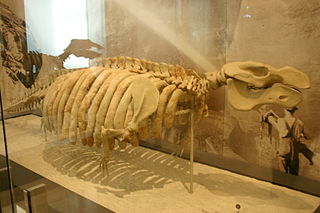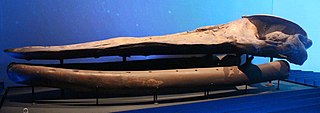
Prosqualodon is an extinct genus of Early to Middle Miocene cetacean from Argentina, Australia, New Zealand and Venezuela.

Macrodelphinus is an extinct genus of primitive odontocete known from Early Miocene marine deposits in California.

Mourasuchus is an extinct genus of giant, aberrant caiman from the Miocene of South America. Its skull has been described as duck-like, being broad, flat, and very elongate, superficially resembling Stomatosuchus from the Late Cretaceous.

Metaxytherium is an extinct genus of dugong that lived from the Oligocene until the end of the Pliocene. Fossil remains have been found in Africa, Europe, North America and South America. Generally marine seagrass specialists, they inhabited the warm and shallow waters of the Paratethys, Mediterranean, Caribbean Sea and Pacific coastline. American species of Metaxytherium are considered to be ancestral to the North Pacific family Hydrodamalinae, which includes the giant Steller's sea cow.
The Colhuehuapian age is a period of geologic time within the Early Miocene epoch of the Neogene, used more specifically within the SALMA classification in South America. It follows the Deseadan and precedes the Santacrucian age.

Gryposuchus is an extinct genus of gavialid crocodilian. Fossils have been found from Argentina, Colombia, Venezuela, Brazil and the Peruvian Amazon. The genus existed during the Miocene epoch. One recently described species, G. croizati, grew to an estimated length of 10 metres (33 ft). Gryposuchus is the type genus of the subfamily Gryposuchinae, although a 2018 study indicates that Gryposuchinae and Gryposuchus might be paraphyletic and rather an evolutionary grade towards the gharial.

Livyatan is an extinct genus of macroraptorial sperm whale containing one known species: L. melvillei. The genus name was inspired by the biblical sea monster Leviathan, and the species name by Herman Melville, the author of the famous novel Moby-Dick about a white bull sperm whale. Herman Melville often referred to whales as "Leviathans" in his book. It is mainly known from the Pisco Formation of Peru during the Tortonian stage of the Miocene epoch, about 9.9–8.9 million years ago (mya); however, finds of isolated teeth from other locations such as Chile, Argentina, United States (California), South Africa and Australia imply that either it or a close relative survived into the Pliocene, around 5 mya, and may have had a global presence. It was a member of a group of macroraptorial sperm whales and was probably an apex predator, preying on whales, seals and so forth. Characteristically of raptorial sperm whales, Livyatan had functional, enamel-coated teeth on the upper and lower jaws, as well as several features suitable for hunting large prey.

Acrophyseter is a genus of extinct sperm whale that lived in the Late Miocene off the coast of what is now Peru. The genus comprises two species: A. deinodon and A. robustus. It is part of a group of macroraptorial sperm whales that all share several features for hunting large prey, such as deeply rooted and thick teeth. Acrophyseter measured 4–4.5 metres (13–15 ft) in length, making it the smallest macroraptorial sperm whale currently known. Because of its short pointed snout and strongly curved front teeth, it probably fed on the large marine vertebrates of its time, such as seals and other whales.
Globidentosuchus is an extinct genus of basal caimanine crocodylian known from the late Middle to Late Miocene of the Middle and the Upper Members of the Urumaco Formation at Urumaco, Venezuela. Its skull was very short and robust, with large units of spherical teeth used to break the shells of molluscs as part of its durophagus diet. It is thought to be one of the most basal Caimanines, even sharing some traits with alligatorids.

Mixocetus is a genus of extinct baleen whale belonging to the family Tranatocetidae. It is known only from the late Miocene (Tortonian) of Los Angeles County, California.
Huaridelphis is an extinct genus of river dolphins from the Early Miocene. The type species is H. raimondii, found in the Chilcatay Formation of the Pisco Basin.

The Pisco Formation is a geologic formation located in Peru, on the southern coastal desert of Ica and Arequipa. The approximately 640 metres (2,100 ft) thick formation was deposited in the Pisco Basin, spanning an age from the Late Miocene up to the Early Pliocene, roughly from 9.6 to 4.5 Ma. The tuffaceous sandstones, diatomaceous siltstones, conglomerates and dolomites were deposited in a lagoonal to near-shore environment, in bays similar to other Pacific South American formations as the Bahía Inglesa and Coquimbo Formations of Chile.

Caiman wannlangstoni is an extinct species of caiman that lived in what is now the Amazon Basin and surrounding areas during the Middle and Late Miocene. Fossils of C. wannlangstoni have been found in the Pebas Formation near Iquitos in Peru and include partial skulls and isolated skull bones. Other fossils were uncovered from the Urumaco Formation in Venezuela and the Laventan Honda Group of Colombia. The species was first described in 2015. Features that in combination distinguish C. wannlangstoni from other caimans include a deep snout, a wavy upper jaw margin, a large and upward-directed narial opening, and blunt teeth at the back of the jaws. Based on the sizes of the skulls, its estimated body length is about 211 to 227 centimetres.
Squalodelphinidae is a family of primitive platanistoid river dolphins, found in marine deposits in the eastern Pacific, western Atlantic, and Europe.

Morenocetus is an extinct genus of primitive balaenid from the Early Miocene Gaiman Formation of Patagonia, Argentina.

Brachydelphis is a genus of pontoporiid known from the Late Miocene Pisco Formation of Peru and the Bahía Inglesa Formation of Chile.
Chilcacetus is an extinct genus of primitive odontocete known from Early Miocene (Aquitanian) of Peru. Fossils were found in and named after the Chilcatay Formation of the Pisco Basin.
Inticetus is an extinct genus of Early Miocene odontocete from the Chilcatay Formation, Pisco Basin, Peru.
Pisco Basin is a sedimentary basin extending over 300 kilometres (190 mi) in southwestern Peru. The basin has a 2 kilometres (6,600 ft) thick sedimentary fill, which is about half the thickness of more northern foreland basins in Peru.
Sacacosuchus is an extinct monospecific genus of marine gavialid that lived along the coast of the south-east Pacific from approximately 19 to 6.3 million years ago. Its fossils have been found in the Chilcatay and Pisco Formations of Peru, where it coexisted with the much larger Piscogavialis. Based on its skull, Sacacosuchus was most likely a generalist feeder with an estimated total body length of 4.32 m (14.2 ft). Its extinction is thought to have been caused by a combination of factors including falling sea levels and global cooling.











